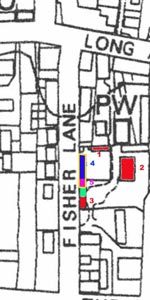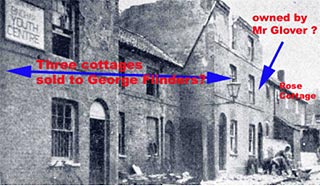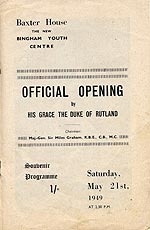7 Fisher Lane Norton Cottage
Background
Norton Cottage is located on higher ground on the east side of Fisher Lane and is south facing. There are is only one small window to the upper storey on the north side, all the other windows face south, to gain maximum light and warmth, as was typical of older buildings in Bingham. (Jasmine Cottage further up Fisher Lane is similarly orientated). It is a three cell cottage with a large central chimney (indicative of the mid 18th century) with hearths on each side. The left hand (western most) room would originally possibly have been unheated but now has a gable wall chimney breast. The walls of the cottage are of mid Victorian three inch thick brick suggestive of a rebuild around the original central chimney; the brick vaulted cellar reveals a mixture of brick sizes from 2½” to 3”. The lower portion of the eastern wall of the cottage is of narrower brick (the top is modern) suggesting this was originally a single storey lean to which was not rebuilt with the rest of the cottage. The window frames have ‘horns’ which would correspond with the mid 1800s. The window frames are modern replacements but probably reflect the original design.
This interpretation of the structure is supported in a surveyor’s report of 1986 which suggested Norton Cottage was built at different stages ‘probably dating back to the mid eighteenth century and constructed in its present style during the mid nineteenth century’. However a cottage is shown on the tithe map of 1841 (property number 303, with 304 – the garden to the south) in the occupation and ownership of James Mann, who also owned and occupied property 147 which was on the north side of Long Acre at the junction with Needham Street. The census for 1841 has James Mann, aged 60, a tailor living in Long Acre with his wife, two female servants and a 5 year old boy named Thomas Bailey. who could have been the son of Mary Bailey a 40 year old draper in Church Street. It is just possible that she was their daughter and that they were ‘fostering’ their grandson, as Mary appears not to have a husband, but at 40 is the right age to be their daughter. Since they were clearly living ‘over the shop, they presumably rented out the cottage. Comparison of the tithe allotment and the census suggests the fourth house in the census list was Norton Cottage, which was occupied by John Wilson, a 55 year old stonemason, with his wife and three children (the oldest was a dressmaker and might even have worked for James Mann. Most other residents of Fisher lane were agricultural laourers and the like; a qualified stonemason might be the kind of person one would expect to live in a slightly more salubrious house than the rest of Fisher Lane at that time!
In 1776 the land was part of a freehold parcel owned by H Sherbrook, successor to the Porter family who had owned about 10% of Bingham. Thus the land has never been part of the Chesterfield Estate. The estate survey from which this information comes did not list freehold houses but there probably was one although we have no idea where it would have been. The prime candidate is Falcon House which dates from this period, but Norton Cottage is another contender as the narrow brick found at could date back as far as 1776 but we have no way of proving it!
At some unrecorded point the freehold for Norton cottage and garden must have passed to Mann and the freehold for the rest would have gone to John Doncaster who built and occupied Providence House next door. However, at some later point Norton Cottage was purchased by whoever owned the latter as the deeds clearly show that along with other cottages at this end of Fisher Lane, Norton Cottage was part of the estate of Providence House, later The Chestnuts (owned by Charles Hayner Curtis), then (from 1923 after its purchase by James Urban Rogers) Orchard Close (the name is carved in the gate post coping stone at the original entrance in Temperance Yard) and now Long Acre House. Norton Cottage retains a right of way from its garden door through the driveway of Long Acre House to this access. Indeed, the electoral roll for 1918 gives Norton Cottage’s address as Long Acre, emphasising its connection with The Chestnuts. The occupant at that time was Annie Moore. These cottages may have been tied houses for staff and/or investment properties for rent. At least some of the cottages probably predate the main house.
We know that Providence House was built and occupied by John Doncaster about 1820; he also gave the land for and probably built the temperance chapel. He was a local builder and figures in many of the deeds we have seen as witness etc. His name occurs in many other references to life in Bingham in the early part of the nineteenth century, suggesting he was an important resident of the town.
Review of deed documents, census, electoral roll and trade directory information
In 1925 the then owner of Orchard Close James Urban Rogers sold three unnamed cottages to George Flinders, a labourer, of Foss Farm for £250. The description was:
All those three cottages which stand situate in Fisher Lane and also the forecourt leading from Fisher Lane to the said hereditaments bounded on the:
North by hereditaments of the vendor
South by hereditaments the property of Mr Glover (listed as a resident of Fisher Lane in the 1925 electoral roll)
East by hereditaments the property of the vendor
West by Fisher Lane.
The cottages were in the occupation of Mr Tole, Mr Nesbit and Mr Palmer. The electoral rolls of autumn 1924 and spring and autumn 1925 list these three as residents of Fisher Lane:
William and Florence Nesbit;
Bingham and Mary Palmer
Ernest and Clara Towle (Autumn 1925 only)
 The electoral rolls also identify the occupants of Norton Cottage as Thomas and Mary Williams (Autumn 1924) and Matilda Lindsay (Autumn 1925, no occupant is listed for Spring 1925) and Rose Cottage as Robert and Hannah Bacon.
The electoral rolls also identify the occupants of Norton Cottage as Thomas and Mary Williams (Autumn 1924) and Matilda Lindsay (Autumn 1925, no occupant is listed for Spring 1925) and Rose Cottage as Robert and Hannah Bacon.
Thus we can be sure this conveyance is not in respect of Norton Cottage.
There was no plan. However, plotting these boundaries on a modern map (left) demonstrates that the three cottages are now part of Priory Mews (4 on the map). The mews were formed out of the redundant youth centre in the 1980s. Four cottages were converted to form the youth centre in 1949, the first youth club in Bingham.
 The photograph (right) of the cottages in their original condition reproduced in the in the opening day programme (below left) show four distinct dwellings, so from the conveyance and the electoral roll entry we can perhaps deduce the most southerly (to the right of the photograph) of these was the one owned by Mr Glover in 1925. In 1949 all four were owned by the Baxter family who made them available to the youth club trustees and so the youth club was named Baxter House. The last occupants had been William Cowdell, Mrs Bake, James Cowdell and C H Cowdell.
The photograph (right) of the cottages in their original condition reproduced in the in the opening day programme (below left) show four distinct dwellings, so from the conveyance and the electoral roll entry we can perhaps deduce the most southerly (to the right of the photograph) of these was the one owned by Mr Glover in 1925. In 1949 all four were owned by the Baxter family who made them available to the youth club trustees and so the youth club was named Baxter House. The last occupants had been William Cowdell, Mrs Bake, James Cowdell and C H Cowdell.
Thus the three properties used as boundary references would have been:
 East - Long Acre House (still owned by the vendor) (2 on the map)
East - Long Acre House (still owned by the vendor) (2 on the map)
North - Norton Cottage (still owned by the vendor) (1 on the map)
South - the fourth cottage (5 on the map).
The conveyance makes it clear that Rose Cottage, presumably what is now Rosehip Cottage, number 15 Fisher Lane (3 on the map) was also owned by the vendor. The purchaser was given rights to use the shared pump, soft water cistern and drains of Rose Cottage. An interesting covenant imposed on the purchaser was that the ‘stained glass window in the cottage overlooking the garden of Orchard Close (no longer present) shall be maintained by the purchaser as the same size as the existing window and no larger one or other than stained glass window shall ever be inserted’. Clearly Mr Urban intended to retain his privacy! He also retained the right to raise the wall between the cottages and Orchard Close.
The second document in the bundle confirms this interpretation, as it records the sale on 25th March 1957 of Orchard Close, Norton Cottage and Rose Cottage by the personal representatives of James Urban Rogers (clearly he had died and this was part of the disposal of his assets) to Steven Robert Armitage. The sale price was £4900 and the land occupied 4300 square yards. It included a right of horse carriage and drift road the width of nine feet to Long Acre - the driveway past the Temperance chapel.
Armitage, now of Hawksworth Manor, sold Norton Cottage to Tony Player on 29 December 1986. The document also records that Long Acre House, as it was now called, was sold on 4th September 1986 to Robert Hand, a managing director, and his wife. There is no mention of Rose Cottage. Armitage had previously received planning permission to convert Long Acre House and Norton Cottage (possibly as the manager’s house) into a residential home for the elderly, but failed to proceed.
